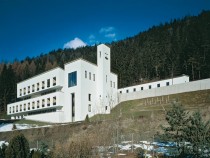
© Markus Bstieler
"Founded in 1846 on the outskirts of Innsbruck, the convent was later engulfed by the expanding city. In search of seclusion, the nuns decided in favour of a new building on an attractive sloping site outside the provincial capital. Although solitude and contemplation play a major role in the Carmelite order, the nuns wished to retain a link with the guest tract, in order to remain in contact with believers who take part in meditation and prayer. Instead of a courtyard that opens to the outside world, as the architect suggested, the nuns’ needs are reflected in a traditional cloister. The architects had to revise a number of their concepts, including that for a more open, communicative chapel. The nuns plan to make their own adjustments, too: the tabernacle, as the most important object in the liturgy, will form the focus of the internal zone; the altar and ambo, on the other hand, can be situated outside the closed area. The latter is shut off by a grating, which allows visual contact between the two realms."



